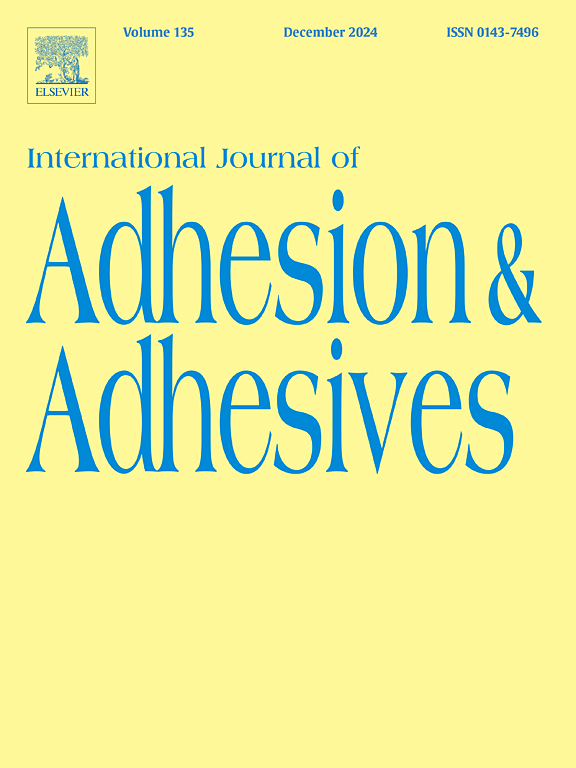Production and characterisation of novel sustainable composite particleboards from cellulosic waste of pineapple peduncles and hybrid tannin-epoxy adhesives
IF 3.5
3区 材料科学
Q2 ENGINEERING, CHEMICAL
International Journal of Adhesion and Adhesives
Pub Date : 2025-09-20
DOI:10.1016/j.ijadhadh.2025.104163
引用次数: 0
Abstract
The use of cellulosic agricultural residues and tannin-rich forestry waste for the production of particleboards offers a sustainable alternative to conventional construction materials. This study develops bio-based composite panels by combining particles derived from pineapple peduncles (containing 45.8–49.3 wt% cellulose) with a partially biobased hybrid adhesive composed of Okan tannin and epoxy resin. The peduncles were transformed into particles with high porosity (75.7 %), significant water absorption capacity (224.3 wt%) and moisture absorption (58.3 wt%). The tannin, extracted via maceration and evaporation, was characterised using 13C NMR spectroscopy and MALDI-TOF mass spectrometry, revealing a composition rich in flavonoids, carbohydrates, and phenolic acids, enhancing its interaction with the epoxy matrix. Panels were manufactured using two particle size ranges (600–1000 μm and 1000–1500 μm) and two adhesive formulations, namely a tannin-epoxy hybrid system (7.5 + 7.5 vol% and 10 + 10 vol%) and pure epoxy (15 and 20 vol%). These fractions were selected to ensure uniform impregnation of the lignocellulosic particles. Characterisation included gravimetric tests, mechanical testing (tensile, three-point bending, internal bonding, Charpy impact). Statistical analysis (ANOVA) confirmed that particle size and adhesive type significantly ( 0.05) affect density, dimensional stability, and mechanical performance. The resulting panels exhibited moderate water absorption ( 50 wt%), good dimensional stability, and robust mechanical properties (tensile strength: 48–50 MPa; flexural strength: 13–14.6 MPa; impact strength: 6–19 J cm−2; hardness: 90 ± 2 HC; internal bonding: 0.62–0.89 MPa), meeting the EN 312 standard requirements for P2-grade boards used in partitioning and furniture manufacturing. This work paves the way for the development of eco-friendly composites and the optimisation of bio-based hybrid adhesives in materials science.

利用菠萝梗纤维素废料和混合单宁-环氧胶粘剂生产新型可持续复合刨花板及表征
利用纤维素农业残留物和富含单宁的林业废弃物生产刨花板,为传统建筑材料提供了一种可持续的替代方案。本研究通过将菠萝梗提取的颗粒(含45.8-49.3 wt%纤维素)与部分生物基混合粘合剂(由奥坎单宁和环氧树脂组成)结合,开发出生物基复合板。竹节转化成高孔隙率(75.7%)、吸水率(224.3 wt%)和吸湿率(58.3 wt%)的颗粒。通过浸渍和蒸发提取的单宁,使用13C NMR波谱和MALDI-TOF质谱进行了表征,揭示了富含黄酮类化合物、碳水化合物和酚酸的成分,增强了其与环氧基质的相互作用。面板采用两种粒径范围(600-1000 μm和1000-1500 μm)和两种粘合剂配方,即单宁-环氧混合体系(7.5 + 7.5 vol%和10 + 10 vol%)和纯环氧(15和20 vol%)。选择这些馏分以确保木质纤维素颗粒的均匀浸渍。表征包括重力测试、机械测试(拉伸、三点弯曲、内部粘合、夏比冲击)。统计分析(ANOVA)证实,颗粒大小和胶粘剂类型显著影响密度、尺寸稳定性和力学性能(p< 0.05)。制成的板材具有中等的吸水率(50% wt%)、良好的尺寸稳定性和坚固的机械性能(抗拉强度:48 - 50mpa;抗折强度:13-14.6 MPa;冲击强度:6 - 19jcm - 2;硬度:90±2hc;内部粘合:0.62-0.89 MPa),符合EN 312对用于隔断和家具制造的p2级板材的标准要求。这项工作为环保复合材料的发展和材料科学中生物基混合粘合剂的优化铺平了道路。
本文章由计算机程序翻译,如有差异,请以英文原文为准。
求助全文
约1分钟内获得全文
求助全文
来源期刊

International Journal of Adhesion and Adhesives
工程技术-材料科学:综合
CiteScore
6.90
自引率
8.80%
发文量
200
审稿时长
8.3 months
期刊介绍:
The International Journal of Adhesion and Adhesives draws together the many aspects of the science and technology of adhesive materials, from fundamental research and development work to industrial applications. Subject areas covered include: interfacial interactions, surface chemistry, methods of testing, accumulation of test data on physical and mechanical properties, environmental effects, new adhesive materials, sealants, design of bonded joints, and manufacturing technology.
 求助内容:
求助内容: 应助结果提醒方式:
应助结果提醒方式:


